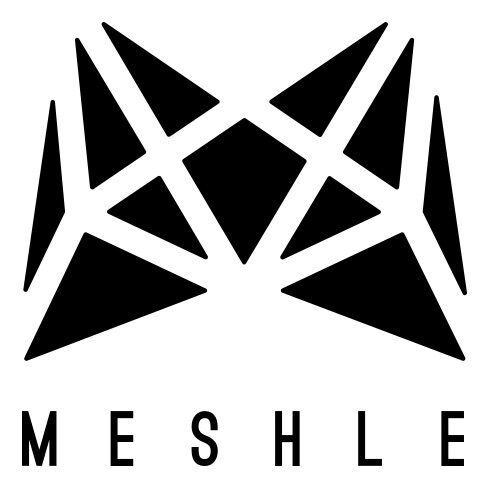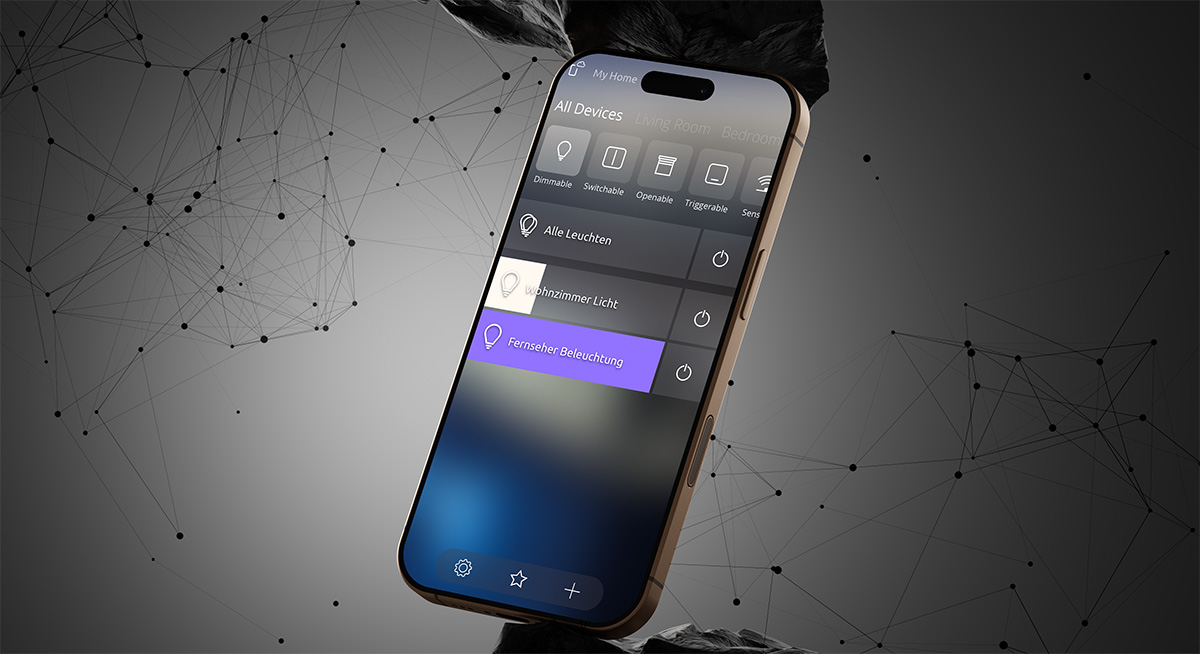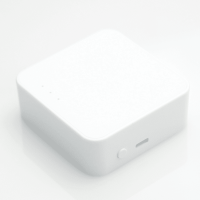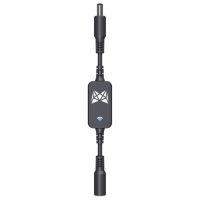Table of Contents
1. Bluetooth Mesh Connectivity and Its Benefits
MESHLE’s smart lighting solution is built on Bluetooth Mesh connectivity, offering robust wireless control without the need for Wi-Fi or centralized hubs. In a Bluetooth Mesh network, devices (like LED drivers and sensors) form a self-healing mesh – each node can relay messages for others, eliminating single points of failure. This means if one light or controller is out of range or offline, messages can hop through other devices, ensuring reliable communication across an entire building. The result is improved range and coverage: a network of Bluetooth Mesh LED drivers can span large areas since signals propagate device-to-device (indoors range can reach ~40m per hop with Bluetooth 5, and even hundreds of meters outdoors with long-range mode). All modern smartphones, tablets, and PCs support Bluetooth, so users can configure and control MESHLE devices directly from a phone – no special gateway required for local operation. This ease of access makes commissioning and controlling lights extremely user-friendly for both consumers and professional installers.
Beyond reliability and convenience, Bluetooth Mesh is secure and scalable. MESHLE devices use industry-standard encryption and authentication (Bluetooth 5 certified), suitable for commercial deployments. The network can support tens or even hundreds of nodes, making it fit for everything from homes to multi-floor offices. By leveraging a widely adopted wireless technology, MESHLE ensures compatibility and future-proofing – you won’t need proprietary bridges, and you benefit from the continual improvements of the Bluetooth ecosystem. In short, Bluetooth Mesh connectivity gives MESHLE installations robust performance, broad coverage, and smartphone-ready control, forming the foundation of a truly wireless lighting infrastructure.
2. MESHLE App – Features, German Engineering, and OEM Customization
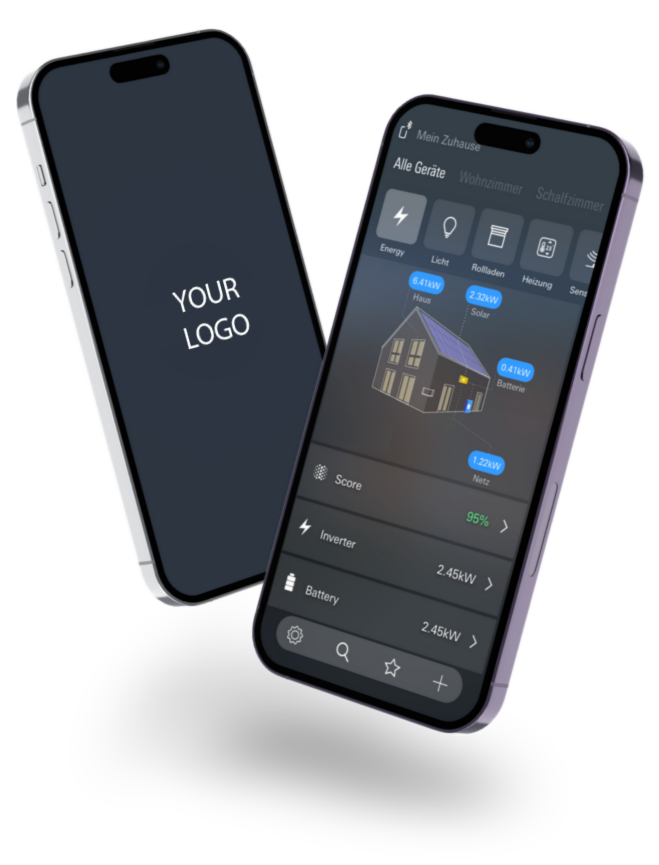 The MESHLE App is the command center for the entire system, thoughtfully designed and developed in Germany to deliver a polished user experience. Available on iOS and Android, the app allows users (or installers) to discover devices, configure networks, and control lights with ease. The user interface automatically adapts to each device type – for example, if you connect an RGB LED controller, the app shows a color wheel and animation effects, whereas a dimmable white light will show a simple brightness slider. This context-aware design ensures the app isn’t cluttered with irrelevant controls, making operation intuitive and efficient.
The MESHLE App is the command center for the entire system, thoughtfully designed and developed in Germany to deliver a polished user experience. Available on iOS and Android, the app allows users (or installers) to discover devices, configure networks, and control lights with ease. The user interface automatically adapts to each device type – for example, if you connect an RGB LED controller, the app shows a color wheel and animation effects, whereas a dimmable white light will show a simple brightness slider. This context-aware design ensures the app isn’t cluttered with irrelevant controls, making operation intuitive and efficient.
Key features of the MESHLE App include: grouping lights by rooms or zones, creating scenes, setting schedules/timers, and even dynamic animations and sound visualizations for compatible lights. A powerful Scene Editor lets you tailor lighting scenes and animations by defining brightness, color, and on/off state for multiple lights at once over time. These scenes can be recalled, and played in sync across multiples mesh nodes, with one tap or even assigned to a wireless switch or voice command for convenience. The app also supports firmware updates OTA (Over-The-Air), so all MESHLE LED drivers and controllers can receive improvements or new features securely via the smartphone – ensuring your lighting system stays up-to-date.
One standout aspect is that the full feature set is completely free to use – the standard MESHLE App has no subscription or “premium” paywalls. Unlike some platforms that charge for advanced features, MESHLE provides the full app at no cost to both end-users and OEM partners. This is a significant advantage for OEMs and installers: you can offer a rich, ready-made control app to your customers without licensing fees. Moreover, for business clients who want their own branding, MESHLE offers white-label/OEM app customization. Manufacturers can license a custom-branded version of the app (with their own app name, logo, and design theme) to present a unified brand experience to users. This OEM app still leverages all of MESHLE’s robust backend and features – a great value for lighting companies who want a turnkey smart lighting app under their own brand.
Notably, the MESHLE App is backed by German engineering and UX design. This emphasis on local development means careful attention to data privacy and security (no unnecessary data collection) and an interface that meets the high expectations of European B2B clients. The app’s development team continuously adds features and improvements via updates, ensuring it stays on the cutting edge of user needs. In summary, the MESHLE App provides feature-rich, intuitive control for the Bluetooth mesh lighting network, and its free availability (with optional OEM branding) makes it an attractive choice for product managers and specifiers looking for a ready-to-go smart lighting control app.
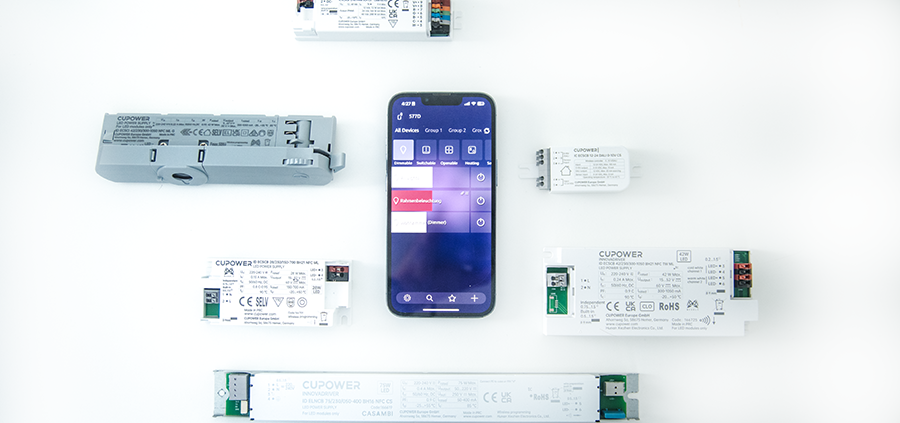
3. Available Products – MESHLE Controllers and LED Drivers (Off‑the‑Shelf and Custom)
The MESHLE App is the command center for the entire system, thoughtfully designed and developed in Germany to deliver a polished user experience. Available on iOS and Android, the app allows users (or installers) to discover devices, configure networks, and control lights with ease. The user interface automatically adapts to each device type – for example, if you connect an RGB LED controller, the app shows a color wheel and animation effects, whereas a dimmable white light will show a simple brightness slider. This context-aware design ensures the app isn’t cluttered with irrelevant controls, making operation intuitive and efficient.
Key features of the MESHLE App include: grouping lights by rooms or zones, creating scenes, setting schedules/timers, and even dynamic animations and sound visualizations for compatible lights. A powerful Scene Editor lets you tailor lighting scenes and animations by defining brightness, color, and on/off state for multiple lights at once over time. These scenes can be recalled, and played in sync across multiples mesh nodes, with one tap or even assigned to a wireless switch or voice command for convenience. The app also supports firmware updates OTA (Over-The-Air), so all MESHLE LED drivers and controllers can receive improvements or new features securely via the smartphone – ensuring your lighting system stays up-to-date.
One standout aspect is that the full feature set is completely free to use – the standard MESHLE App has no subscription or “premium” paywalls. Unlike some platforms that charge for advanced features, MESHLE provides the full app at no cost to both end-users and OEM partners. This is a significant advantage for OEMs and installers: you can offer a rich, ready-made control app to your customers without licensing fees. Moreover, for business clients who want their own branding, MESHLE offers white-label/OEM app customization. Manufacturers can license a custom-branded version of the app (with their own app name, logo, and design theme) to present a unified brand experience to users. This OEM app still leverages all of MESHLE’s robust backend and features – a great value for lighting companies who want a turnkey smart lighting app under their own brand.
Notably, the MESHLE App is backed by German engineering and UX design. This emphasis on local development means careful attention to data privacy and security (no unnecessary data collection) and an interface that meets the high expectations of European B2B clients. The app’s development team continuously adds features and improvements via updates, ensuring it stays on the cutting edge of user needs. In summary, the MESHLE App provides feature-rich, intuitive control for the Bluetooth mesh lighting network, and its free availability (with optional OEM branding) makes it an attractive choice for product managers and specifiers looking for a ready-to-go smart lighting control app.
4. Supported Profiles – Dimmer, CCT, RGB and Flexible Multi-Channel Control
The MESHLE App is the command center for the entire system, thoughtfully designed and developed in Germany to deliver a polished user experience. Available on iOS and Android, the app allows users (or installers) to discover devices, configure networks, and control lights with ease. The user interface automatically adapts to each device type – for example, if you connect an RGB LED controller, the app shows a color wheel and animation effects, whereas a dimmable white light will show a simple brightness slider. This context-aware design ensures the app isn’t cluttered with irrelevant controls, making operation intuitive and efficient.
Key features of the MESHLE App include: grouping lights by rooms or zones, creating scenes, setting schedules/timers, and even dynamic animations and sound visualizations for compatible lights. A powerful Scene Editor lets you tailor lighting scenes and animations by defining brightness, color, and on/off state for multiple lights at once over time. These scenes can be recalled, and played in sync across multiples mesh nodes, with one tap or even assigned to a wireless switch or voice command for convenience. The app also supports firmware updates OTA (Over-The-Air), so all MESHLE LED drivers and controllers can receive improvements or new features securely via the smartphone – ensuring your lighting system stays up-to-date.
One standout aspect is that the full feature set is completely free to use – the standard MESHLE App has no subscription or “premium” paywalls. Unlike some platforms that charge for advanced features, MESHLE provides the full app at no cost to both end-users and OEM partners. This is a significant advantage for OEMs and installers: you can offer a rich, ready-made control app to your customers without licensing fees. Moreover, for business clients who want their own branding, MESHLE offers white-label/OEM app customization. Manufacturers can license a custom-branded version of the app (with their own app name, logo, and design theme) to present a unified brand experience to users. This OEM app still leverages all of MESHLE’s robust backend and features – a great value for lighting companies who want a turnkey smart lighting app under their own brand.
Notably, the MESHLE App is backed by German engineering and UX design. This emphasis on local development means careful attention to data privacy and security (no unnecessary data collection) and an interface that meets the high expectations of European B2B clients. The app’s development team continuously adds features and improvements via updates, ensuring it stays on the cutting edge of user needs. In summary, the MESHLE App provides feature-rich, intuitive control for the Bluetooth mesh lighting network, and its free availability (with optional OEM branding) makes it an attractive choice for product managers and specifiers looking for a ready-to-go smart lighting control app.
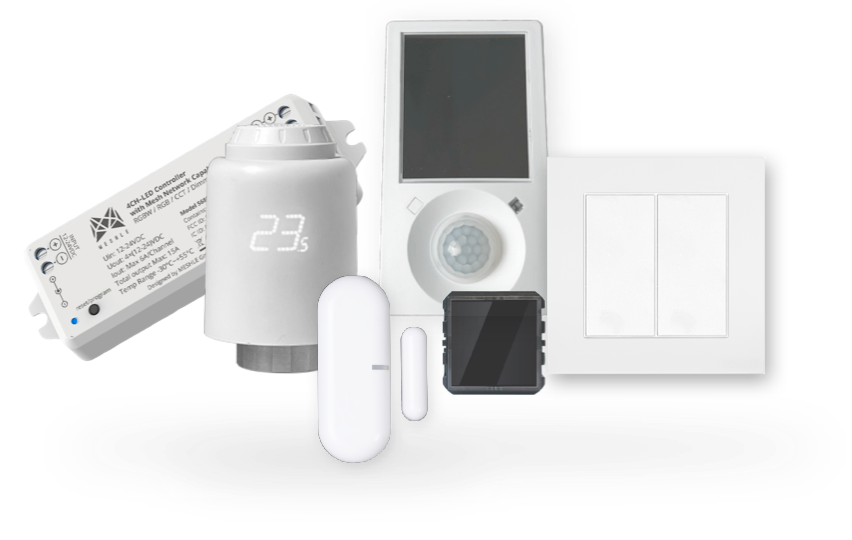
5. Accessories – Wireless Kinetic Switches and Presence Sensors for Automation
A great lighting ecosystem goes beyond drivers and lamps – MESHLE supports a range of accessories to enrich the user experience and automation. Two key accessory types are battery-free wireless switches and presence/motion sensors.
A MESHLE-compatible kinetic wall switch (double rocker) that requires no batteries. Pressing the switch generates enough energy to send a Bluetooth Mesh command, allowing wireless control of lights. In MESHLE app, each rocker can be assigned to different scenes or devices. Alt: White double-rocker wireless light switch on a wall.
Wireless Kinetic Switches: MESHLE offers a battery-free wireless wall switch that uses kinetic energy (EnOcean technology) to send commands to the mesh. Simply pressing the rocker generates a small electrical charge that powers a Bluetooth signal – meaning no batteries or wiring are needed at all. The switch can be surface-mounted anywhere (or even kept loose as a remote), providing tremendous flexibility in placement. The model is a double-rocker style, effectively giving four trigger points (rocker A up/down, and rocker B up/down). Through the MESHLE App, each can be configured to control different functions: you could toggle certain lights on/off, dim a group, change colors, activate scenes, or even execute a “master off” for all lights. For example, one rocker could turn all office lights on/off, while the other cycles through preset scenes. Because it’s integrated via Bluetooth Mesh, every MESHLE light can respond to these switches – you’re not limited to one-to-one pairing as with some proprietary wireless switches. Setting up the switch is straightforward: you put the network in provisioning mode (or scan a QR code if provided for easy inclusion) and simply click the switch, and it gets added to the mesh. From there, assignments can be done in the app’s scene editor or device settings. (Video demonstration placeholder: e.g. a short clip showing how a user scans a QR code on the switch and links it to a light group.) The use of kinetic (self-powered) switches is ideal for retrofits and energy-conscious projects – you can install wall switches without pulling cables or ever replacing batteries. This plays into human-centric design by giving end-users familiar tactile controls alongside app and voice control.
Presence Sensors: Automation is a key part of smart lighting in offices and commercial buildings, and MESHLE supports presence detection via sensors. In fact, the firmware has a profile for presence (motion) sensors, and there are ready-to-use sensor devices in the ecosystem (e.g. PIR motion detectors or multi-sensors that detect movement, ambient light, temperature, etc.). These sensors can join the Bluetooth Mesh network and directly trigger lighting changes based on occupancy or daylight. For instance, a ceiling-mounted PIR sensor could be configured to send a command to certain lights (or a group address) to turn on when motion is detected and turn off after a period of no motion. Because it’s all on the mesh, the response is local and instantaneous – no cloud needed, and multiple sensors and lights can interact. MESHLE has demonstrated how presence sensors work in a smart office scenario (see our blog post on energy-saving with presence sensors for more details and real-world examples). With the MESHLE App, you can adjust sensor-triggered behaviors, such as setting luminance thresholds (so lights stay off if there’s sufficient daylight) or defining schedules when motion-based control is active (e.g. only after hours or in specific zones). (Link to detailed blog post about presence-based lighting control placeholder.)
Integrating accessories like these enriches the overall solution: wireless kinetic switches provide instant manual control points (great for guests or override controls), and sensors enable intelligent automation that can significantly improve energy efficiency and comfort. MESHLE’s ecosystem approach means these accessories are not add-ons in isolation – they are part of the same unified network and configured through the same app. This reduces complexity for system integrators: a single platform handles both the lighting outputs and the input devices. For product managers and OEMs, offering such accessories (or compatibility with them) adds value to the lighting solution, making it more attractive as a complete smart lighting package.
6. MESHLE Cloud – Local-First Control with Optional Cloud Connectivity
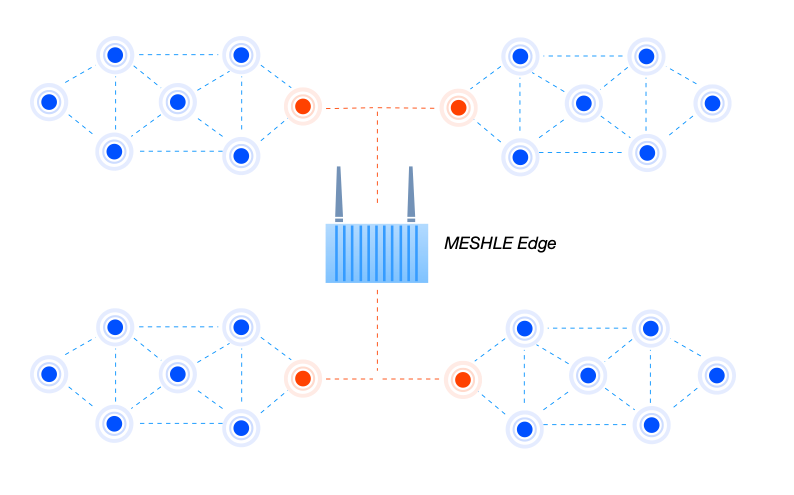
MESHLE’s philosophy is “local-first” – you can do everything needed (provisioning, control, automation) with the local mesh network and the app. However, for those who want remote access, centralized monitoring, or large-scale management, the MESHLE Cloud is available as an opt-in service. The cloud functionality is delivered with upgrade of MESHLE Gateway in the mesh network, which then unlocks additional capabilities like remote control, data analytics, and voice assistant integration. If you don’t need these features, your lights stay entirely local – ensuring no dependence on internet for day-to-day use. The system works out-of-the-box without forcing cloud accounts, but the value-added services are there when needed.
When activated, MESHLE Cloud connects to your on-site mesh network through a gateway (detailed in the next section). The design is such that all core functions remain on-site, and the cloud mainly provides a tunnel and interface for remote interactions. MESHLE emphasizes data security – the cloud server is developed and hosted in Germany, with strict encryption and no outsourcing to big third-party cloud providers. For European customers, this means compliance with GDPR and reassurance that data (like device status or usage metrics) is stored under local jurisdiction. This focus on privacy and security is a key differentiator for enterprise and hospitality clients who might be wary of cloud solutions.
What does the Cloud offer? First, it enables remote control via the MESHLE App from anywhere. Once your network is linked, you’ll see a “Cloud” connection option in the app, allowing you to control your lights when away from the site (for example, adjusting a showroom’s lights from headquarters). Multiple sites/networks can be managed under one cloud account – useful for a company managing many locations. Second, the cloud opens up voice control integration. MESHLE integrates with popular voice assistants by bridging through the cloud: you can link an Amazon Alexa account the MESHLE Cloud and then control devices with voice commands. (There is a dedicated MESHLE Alexa Skill that, once enabled and linked, discovers your mesh-connected lights and allows natural voice commands like “Alexa, turn on the conference room lights.”) The cloud also keeps all devices’ time synchronized for scheduling accuracy. Third, the cloud provides a web dashboard (coming soon per roadmap) for management and analytics. This web interface will be valuable for facility managers to see status at a glance, view energy usage or sensor data, and manage settings from a PC.
For advanced integrations, the MESHLE Cloud exposes standard APIs – notably, it uses MQTT under the hood. This means a tech-savvy client can hook the MESHLE system into their broader building management system or IoT platform by subscribing/publishing to MQTT topics. Essentially, the Bluetooth mesh gets bridged to the internet in a secure way, and then open protocols are used, enabling integration with third-party services or custom applications (for example, linking MESHLE lighting with a hotel’s management software to automate room lighting based on check-in status). Alternatively to the Cloud on remote servers, the cloud component can be deployed and ran on an industrial PC or server to be inside of intranet. This scalability and flexibility make the solution suitable for not just homes but also enterprise, commercial, and industrial applications.
In essence, MESHLE Cloud adds a layer of centralized control and connectivity without compromising the local autonomy of the system. It’s an opt-in upgrade that brings in remote access, voice control (Alexa, Google, etc.), and cross-system integration. For many B2B customers – like property managers or nationwide retailers – this capability is critical, and MESHLE delivers it in a secure, Europe-hosted, and scalable manner. Local-first when you want it, cloud-powered when you need it: the best of both worlds.
7. Gateways – Bridging Bluetooth Mesh to Internet or Intranet, with Matter and PoE Options
To enable the cloud connectivity and voice integrations discussed above, MESHLE provides gateway devices that act as a bridge between the Bluetooth Mesh network and other networks (Wi-Fi/Ethernet, and even Thread/Matter). The gateways ensure that the mesh devices can be accessed over the internet and also interface with smart home ecosystems. MESHLE currently offers two versions: a standard Gateway and an upgraded Gateway Pro (Matter-enabled), catering to different project needs.
The MESHLE Gateway (standard version) is a compact plug-and-play device that connects to the local network via Wi-Fi or Ethernet. Once powered and set up via the MESHLE App, it becomes the liaison between your mesh lights and the cloud. The setup is straightforward: you connect the gateway to power (it can even be inline between a LED controller and its power supply to avoid needing a separate outlet, which is a clever option), then use the app to register it to your cloud account and mesh network, and finally enable the Alexa integration. In minutes, your previously local-only network is online and voice-enabled. This small gateway is ideal for homes and small businesses. It’s cost-effective and easy to hide in a ceiling or cabinet. Despite its size, it supports the full feature set – remote app control, scheduling via cloud, and voice commands.
The MESHLE Matter Gateway (Gateway Pro) takes things a step further by adding support for the new Matter smart home protocol. This device also includes a Wi-Fi module and LAN port with Power-over-Ethernet (PoE) capability. In practice, the MESHLE Matter Gateway functions not only as a cloud bridge but also as a Matter bridge, allowing your Bluetooth Mesh lights to be exposed in Matter ecosystems. This means MESHLE-controlled lights can appear in Apple Home, Google Home, or any Matter-compatible app, as if they were native devices. For example, with the Matter gateway, you can commission the mesh network into Apple HomeKit via Matter – letting Siri control the lights and having them in the Apple Home app (no proprietary HomeKit code needed, Matter handles the translation). Similarly, Alexa and Google Home can integrate via Matter, though MESHLE also supports them directly as noted. The Gateway Pro is thus perfect for projects that require deep integration with building systems or want to leverage the multi-admin interoperability of Matter (e.g., a hotel might give guests Apple Home control of lights in their room via QR code onboarding with Matter – which the MESHLE gateway can facilitate). The inclusion of PoE means the device can be installed with just a single Ethernet cable providing both data and power – ideal for placing it on ceilings or IT racks in commercial environments where power outlets may be limited but network drops are available. PoE also implies a stable wired backhaul, which can be preferable for robust operation in enterprise settings.
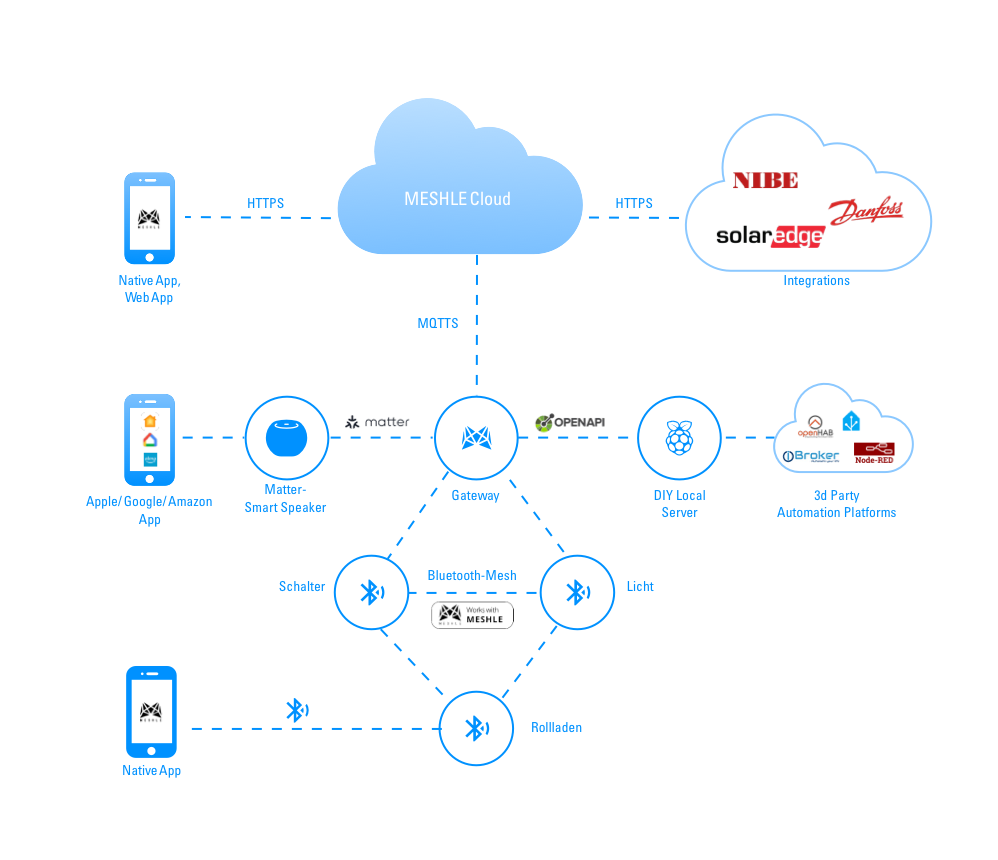
Both gateways are managed through the MESHLE App and can be updated OTA for new features. Security is a top priority – they use secure protocols to communicate with the cloud, and only authorized accounts can access the network. The Matter Gateway in particular undergoes Matter certification, ensuring it meets the encryption and interoperability standards of that protocol. For the end user, having a gateway means they get the convenience of voice control (“Alexa, turn off all lights”) and remote management, while still retaining local control (if the internet goes down, the lights continue to work with local app and switches). For the OEM or integrator, offering a gateway expands the market of the lighting solution – it can now tie into smart home platforms and provide features like dashboard analytics and multi-site control that larger clients demand.
In summary, MESHLE’s gateways complete the ecosystem by linking the Bluetooth Mesh world to the broader IoT and smart home world. Whether it’s the basic gateway for simple remote access or the advanced Matter-enabled gateway for maximum integration, these devices ensure that a MESHLE-based lighting system can operate standalone or as part of a bigger connected system. (Video placeholder: )
8. Ecosystem Support – Actuators, Sensors, and Third-Party Integrations
While lighting is the focus, the MESHLE ecosystem is versatile and extends to many other device types that complement a smart building. This broad support allows MESHLE to function as more than just a lighting control system – it can be a unified smart building platform for OEMs and integrators.
In terms of hardware, MESHLE’s technology can be found in actuators such as relay switches, plug adapters, motor controllers, and more. For example, there is a MESHLE roller shutter module (for motorized blinds or shades) that lets you open/close or adjust position via the same app – imagine controlling your window blinds and lights in one scene for a meeting room. There are also general-purpose switch actuators (to turn appliances or circuits on/off) which could be used for fans, pumps, or other equipment. Because the underlying mesh is the same, these actuators can interoperate with lighting devices. A real-world scenario: a wall switch (battery-free, as described earlier) could simultaneously trigger both lights and an actuator – perhaps turning on a lamp and a ventilation fan together. Or a “Good Night” scene could not only dim the lights but also close the blinds (shutter actuator) and turn off a decorative water fountain. This convergence of control simplifies user experience and integration costs.
On the sensor side, beyond presence sensors, MESHLE supports an array of environmental sensors: temperature, humidity, light level (lux), air quality (VOC/CO2), door/window contacts, etc.. All these sensors can feed into automation logic. For instance, a light sensor could measure daylight and gradually dim electric lights to maintain a constant illuminance (a daylight harvesting strategy for energy savings). Or an air quality sensor could trigger a color change in an RGB panel (turning it red if CO2 levels are high as a warning indicator). The possibilities are broad – essentially, any condition can be linked to any action within the mesh. MESHLE’s app and upcoming dashboard aim to make configuring these linkages user-friendly, but for advanced users, the openness of the system (via MQTT and APIs) means they can craft custom logic in external systems if desired.
Speaking of integration, the non-Bluetooth integrations via the cloud make MESHLE a bridge between Bluetooth Mesh devices and other IoT ecosystems. We’ve already touched on voice assistants and Matter. Additionally, because the MESHLE Cloud uses MQTT, it can connect with services like Node-RED, openHAB, Home Assistant, or any MQTT-compatible platform relatively easily. An integrator can subscribe to MESHLE’s MQTT topics to monitor device states or publish commands to control devices. This effectively means a MESHLE lighting network could be integrated into a larger building management system (BMS) or an industrial automation system. For example, a factory might use a central system that controls machines and indicates statuses via tower lights – by integrating MESHLE LED controllers in those tower lights and connecting through MQTT, the factory’s main software could directly change colors or blink patterns based on machine states. In a smart home scenario, if someone has other wireless tech (Zigbee, Z-Wave, etc.), those can be tied in at a higher level using something like Home Assistant bridging to MESHLE via MQTT. MESHLE becomes the Bluetooth Mesh interface in a multi-protocol environment, and thanks to standard APIs, it doesn’t lock you out from coordinating with those other protocols.
For lighting OEMs and B2B partners, this broad ecosystem means when you choose MESHLE, you’re getting more than just a light dimmer – you’re plugging into a full suite of smart building capabilities. You can start by offering your customers app-controlled lights, then later upsell sensors for automation, add voice control, or integrate with building management dashboards, all using the same MESHLE platform. It’s a scalable solution that can start small (just a few lights and one app) and expand to enterprise scale (multiple sites, many device types, cloud analytics) as value is proven. By supporting a wide ecosystem, MESHLE helps ensure that your investment in Bluetooth Mesh control can serve a variety of needs and remain relevant for years to come, even as technology trends evolve.
9. Partnership-Focused Call to Action – Quality and Value Over Volume
MESHLE’s Bluetooth Mesh LED drivers and smart lighting ecosystem offer a cutting-edge yet practical solution for modern lighting control. But what truly sets MESHLE apart is our approach to partnership. We believe in creating value over sheer volume – meaning we prioritize close collaboration, customization, and long-term support for our partners rather than just pushing boxes off a shelf. If you are a product manager, lighting specifier, OEM, or technology integrator looking for a flexible and reliable way to add wireless lighting control to your offerings, MESHLE is eager to work with you.
By choosing MESHLE, you’re not just buying a product – you’re gaining a development partner. Our team of experienced hardware and software engineers will support you through every phase, from concept to integration to deployment. Whether you need a quick solution using our off-the-shelf controllers or a fully custom firmware profile for a unique application, we are here to ensure you succeed. We can help tailor the app to your brand, adjust firmware to your hardware design, or even develop new features that give your solution a competitive edge. Our goal is to empower you to deliver exceptional smart lighting experiences to your customers with minimal hassle and maximal impact. And as your needs grow – perhaps integrating other systems or scaling to thousands of nodes – MESHLE will scale with you, providing the cloud infrastructure or on-premise solutions required.
We also understand the importance of reliability and trust in B2B relationships. All our products are tested to meet strict quality standards, and being a German company, we uphold high standards in data security and compliance. You can confidently present MESHLE-enabled solutions to even your most demanding clients (be it a government project concerned about data locality or a large enterprise needing uptime and support) and tick all the boxes. Our existing partnerships (such as with established LED driver manufacturers and industrial clients) speak to the robustness and credibility of our technology.
So, if you’re ready to transform your lighting products with wireless mesh connectivity, or if you’re searching for a cohesive platform to unify lighting, sensors, and controls, let’s talk. MESHLE is actively seeking partnerships with OEMs and distributors who share our vision of smart lighting that is easy, interoperable, and user-centric. Together, we can create lighting solutions that delight end-users and open new revenue streams for your business. Reach out to us today to explore how MESHLE can add value to your projects – from enhancing the appeal of your product line to simplifying installation and commissioning for your team. We’re confident that once you experience the seamless integration and powerful capabilities of our Bluetooth Mesh ecosystem, you’ll see why so many are choosing MESHLE as the backbone of their smart lighting strategy.
Let’s build the future of smart lighting, one successful partnership at a time – written with love ❤️
